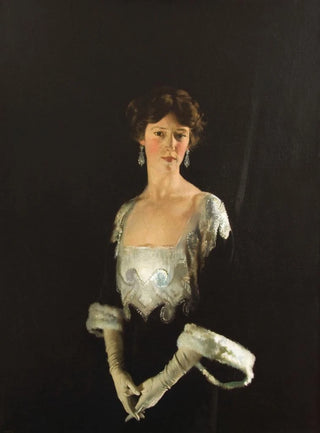Art print | Portrait of Rose, Fourth Marchioness of Headfort - William Orpen


View from behind

Frame (optional)
Portrait of Rose, the Fourth Marchioness of Headfort - William Orpen – Captivating Introduction
The "Portrait of Rose, the Fourth Marchioness of Headfort" by William Orpen is a work that transcends the simple realm of painting to engage in an timeless dialogue between art and nobility. This depiction of a woman from British high society, imbued with grace and dignity, invites viewers to immerse themselves in a universe where elegance and sophistication meet. Through this portrait, Orpen does not merely capture the physical appearance of his model but also manages to evoke a psychological depth, a personal story that can be sensed behind the marchioness's gaze. In a constantly evolving world, this artwork remains a poignant testament to the era and the morals that shaped it.
Style and uniqueness of the work
Orpen's style is distinguished by its ability to blend realism with a subtle impressionist touch. In the "Portrait of Rose," every brushstroke is carefully considered, every shade of color chosen with precision. The marchioness's face, illuminated by soft light, appears almost alive, while the details of her dress evoke the richness of fabrics from the period. The interplay of shadow and light, along with the delicate color palette, gives the piece an intimate and warm atmosphere. Orpen succeeds in capturing not only the appearance of his model but also her essence, her character. Rose's gaze, both proud and melancholic, challenges us and invites reflection on the expectations and constraints placed on women of her time.
The artist and his influence
William Orpen, an emblematic figure of early 20th-century British painting, established himself as a master of portraiture. His artistic journey, marked by training at the Slade School of Fine Art and a notable influence from French Impressionists, allowed him to develop a unique style that combines technical precision with emotional sensitivity. Orpen painted many figures from high society, but it is his ability to reveal the soul of his models that sets him apart. His work has not only influenced his contemporaries but continues to inspire artists today. Through his portraits, he

Matte finish

View from behind

Frame (optional)
Portrait of Rose, the Fourth Marchioness of Headfort - William Orpen – Captivating Introduction
The "Portrait of Rose, the Fourth Marchioness of Headfort" by William Orpen is a work that transcends the simple realm of painting to engage in an timeless dialogue between art and nobility. This depiction of a woman from British high society, imbued with grace and dignity, invites viewers to immerse themselves in a universe where elegance and sophistication meet. Through this portrait, Orpen does not merely capture the physical appearance of his model but also manages to evoke a psychological depth, a personal story that can be sensed behind the marchioness's gaze. In a constantly evolving world, this artwork remains a poignant testament to the era and the morals that shaped it.
Style and uniqueness of the work
Orpen's style is distinguished by its ability to blend realism with a subtle impressionist touch. In the "Portrait of Rose," every brushstroke is carefully considered, every shade of color chosen with precision. The marchioness's face, illuminated by soft light, appears almost alive, while the details of her dress evoke the richness of fabrics from the period. The interplay of shadow and light, along with the delicate color palette, gives the piece an intimate and warm atmosphere. Orpen succeeds in capturing not only the appearance of his model but also her essence, her character. Rose's gaze, both proud and melancholic, challenges us and invites reflection on the expectations and constraints placed on women of her time.
The artist and his influence
William Orpen, an emblematic figure of early 20th-century British painting, established himself as a master of portraiture. His artistic journey, marked by training at the Slade School of Fine Art and a notable influence from French Impressionists, allowed him to develop a unique style that combines technical precision with emotional sensitivity. Orpen painted many figures from high society, but it is his ability to reveal the soul of his models that sets him apart. His work has not only influenced his contemporaries but continues to inspire artists today. Through his portraits, he






